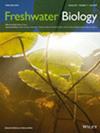野火对线虫寄生虫、蜉蝣寄主和鳟鱼捕食者相互作用的影响
IF 2.8
2区 生物学
Q2 ECOLOGY
引用次数: 0
摘要
野火活动在全球范围内不断增加,这凸显了了解火灾干扰如何影响物种相互作用的必要性。特别是,很少有研究调查了火如何影响淡水溪流中寄生虫、宿主和捕食者之间的相互作用。我们研究了寄主-寄生虫和寄主-捕食者的相互作用,包括线虫寄生虫(Mermithidae科),蜉蝣目寄主(蜉蝣目)和鳟鱼捕食者(Salvelinus fontinalis, Salmo trutta和Oncorhynchus clarkii)在严重野火发生后的2年里,在落基山脉南部8个被烧毁和8个未被烧毁的溪流地点。火灾发生1年后,烧伤地点的蜉蝣密度、感染概率和感染蜉蝣密度(感染蜉蝣/m2)均较低,但2年后恢复到与未烧伤地点相似的水平。感染蝇密度随蝇总密度的增加而增加;然而,在烧伤和未烧伤的河流中,感染率(%)在0%至26%之间,并且可能蝇密度与感染患病率之间没有关系。通过对2万只蜉蝣的解剖分析,贝氏科中等大小(4-6毫米)的蜉蝣感染概率最高,也是鳟鱼胃中最常见的蜉蝣科和大小纲。野火不影响每条鳟鱼消耗的绿腹虫数量,鳟鱼消耗的蜉蝣感染流行率明显低于底栖动物,这表明受感染的蜉蝣有捕食者躲避行为。总体而言,我们的研究结果表明,狭缝虫对火灾的响应反映了寄主密度的变化,与狭缝虫的单寄主生命周期一致。这些结果有助于将宿主-寄生虫-捕食者的相互作用整合到我们对淡水溪流中干扰生态学的理解中,并对寄生虫在食物网能量流动中的作用产生影响。本文章由计算机程序翻译,如有差异,请以英文原文为准。
Effects of Wildfire on Interactions Among Nematode Parasites, Mayfly Hosts and Trout Predators
- Wildfire activity is increasing globally, highlighting the need to understand how fire disturbance affects species interactions. In particular, few studies have examined how fire influences interactions among parasites, hosts and predators in freshwater streams.
- We characterised host–parasite and parasite–predator interactions involving nematode parasites (Family Mermithidae), mayfly hosts (Order Ephemeroptera) and trout predators (Salvelinus fontinalis, Salmo trutta and Oncorhynchus clarkii) at 8 burned and 8 unburned stream sites in the southern Rocky Mountains for 2 years following severe wildfires.
- Mayfly density, infection probability, and density of infected mayflies (infected mayflies/m2) were all lower at burned sites 1 year after fire but returned to levels similar to unburned sites after 2 years. Density of infected mayflies increased with overall mayfly density; however, infection prevalence (%) ranged from 0% to 26% across burned and unburned streams, and there was no relationship between mayfly density and infection prevalence.
- Based on dissections of > 20,000 mayflies, intermediate-size (4–6 mm) mayflies in the family Baetidae had the highest infection probability and were also the most common mayfly family and size class found in trout stomachs. Wildfire did not affect the number of mermithids consumed per trout, and infection prevalences of mayflies consumed by trout were significantly lower than in the benthos, suggesting predator-avoidance behaviour by infected mayflies.
- Overall, our results suggest that mermithid nematode responses to fire reflected changes in host density, consistent with the single-host life cycle of mermithids. These results help integrate host–parasite–predator interactions into our understanding of disturbance ecology in freshwater streams, with implications for parasite roles in energy flow through food webs.
求助全文
通过发布文献求助,成功后即可免费获取论文全文。
去求助
来源期刊

Freshwater Biology
生物-海洋与淡水生物学
CiteScore
5.90
自引率
3.70%
发文量
162
审稿时长
2 months
期刊介绍:
Freshwater Biology publishes papers on all aspects of the ecology of inland waters, including rivers and lakes, ground waters, flood plains and other freshwater wetlands. We include studies of micro-organisms, algae, macrophytes, invertebrates, fish and other vertebrates, as well as those concerning whole systems and related physical and chemical aspects of the environment, provided that they have clear biological relevance.
Studies may focus at any level in the ecological hierarchy from physiological ecology and animal behaviour, through population dynamics and evolutionary genetics, to community interactions, biogeography and ecosystem functioning. They may also be at any scale: from microhabitat to landscape, and continental to global. Preference is given to research, whether meta-analytical, experimental, theoretical or descriptive, highlighting causal (ecological) mechanisms from which clearly stated hypotheses are derived. Manuscripts with an experimental or conceptual flavour are particularly welcome, as are those or which integrate laboratory and field work, and studies from less well researched areas of the world. Priority is given to submissions that are likely to interest a wide range of readers.
We encourage submission of papers well grounded in ecological theory that deal with issues related to the conservation and management of inland waters. Papers interpreting fundamental research in a way that makes clear its applied, strategic or socio-economic relevance are also welcome.
Review articles (FRESHWATER BIOLOGY REVIEWS) and discussion papers (OPINION) are also invited: these enable authors to publish high-quality material outside the constraints of standard research papers.
 求助内容:
求助内容: 应助结果提醒方式:
应助结果提醒方式:


